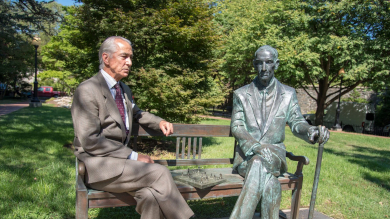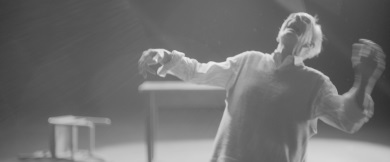The Actor and the Hero

The intersections and “joint-ventures” between cinema and theatre are as old as cinema itself, but sometimes (and not very often), the act of combining these two arts results in a perfect, significant, and ideal match.
Who or what makes this dramaturgic alignment happen? In this case, it is the actor. In Remember This (USA 2022, directed by Derek Goldman and Jeff Hutchens, also director of photography) it is the extraordinary performance delivered by David Strathairn, an actor whose career and craft span from theater to movies and tv series, from blockbusters (Godzilla) to more intimate performances such as An Interview with God. The movie is the final “stage” or evolution of a theatrical pièce on Jan Karski, a legendary professor of the Jesuit Georgetown University in Washington D.C.
Jan Karski (Łódź Poland 1914-Washington D.C. US 2000) was a professor in the School of Foreign Service at Georgetown University for many years following WWII. Born a catholic in Poland, he was a brilliant student, and after some time in the army, he joined the diplomatic service and later the Polish resistance. His extremely relevant contribution to the history of WWII (and I would also say to the history of humankind) was his report to the Allies about the existence of the death camps and the extermination of the Jews, a reality that he witnessed first-hand. His “cry for help” was the first of its kind conveyed to the Allies and was not listened or believed. This dramatic outcome is basically at the center of the movie and of Karski's life and legacy. President Obama awarded Karski posthumously with the Presidential Medal of Freedom, the highest civilian honor in the United States.

The set is extremely simple: a table, a couple of chairs, and a few objects (“robbe,” as an old Italian actor or actress would have called them); the entire show revolves around the extraordinary performance of Strathairn. The passage from the stage to the film is therefore underlined by the stage-like set. But it is not a recording of the theatrical pièce, it is a movie in its own right with its own dramaturgic pace which, while essential, is definitely cinematographic.
Strathairn/Karski, begins his narration of the events: his family and his studies, his first assignments as a diplomat, the invasion of the Nazis, the deportations and the death camps, and the consequent horror. Strathairn adopts a light eastern European accent which is not invasive nor over-characteristic. The narration of the facts is “prismatic” and Strathairn/Karski revives the conversations and answers of the many people he talked to (he also imitates the interlocutors - I wish to mention his noteworthy impression of President F. D. Roosevelt), including a Jewish refugee he met in London who commits suicide out of desperation for his people and due to the indifference of those who could have acted but did nothing.
The cinematography is elegant: black and white with some “nuances”, as the lights replicate a theatrical atmosphere but, as I was saying, they are elements of cinema not just theater.
The artists of the Italian Renaissance asserted that the “arte del togliere” (the “art of taking out”) was a part of artistic creation; they intended that the artist must find the essence of beauty. In Remember This the spectator is provided only with the essential and what is not relevant to the narration of the unspeakable and to the performance is wisely left out. In the end it is the camera that works for the actor and the actor, in this case, works the camera: the actor becomes the camera (see B. Keaton in Film by S. Beckett, USA 1965).

The fluidity of the narration of the events is at the center of the cinematic experience of the movie and the authors balance the various “voices” admirably, leading us to the heart of the tragic memory of the Holocaust.
Karski was basically alone in his cry for help and so is the protagonist of the movie who remembers the stories and facts in front of the public. The relationship between the actor on-screen and the public in the seats is therefore unique in this movie. The actor, thanks to the set and the “memory” of the theatrical nature of the original text by Clark Young and D. Goldman, reaches out to the spectators in a very direct and at times strong way.
The whole project (in other words, Strathairn/Karski's entire performance) has one single purpose: as the title explicitly states, people must remember, and Strathairn/Karski's last line is “remember this” (an interesting and refined phrase, given that Strathairn drops his “Polish accent” and recites it with his natural accent). The spectator of the movie becomes a witness, and the actor—since he is representing/narrating a true story witnessed by a true historic figure—becomes the incarnation of the memory. Strathairn/Karski, though, is not the shaman of the ancient times (too often this figure has been used), but rather a common person, a decent man who wants to do the right thing against all odds and persists against all odds (including torture); therefore, he is compelled to share the story in order to prevent other horrors, with some emphases that are never “melodramatic” or over-acted. This, in my view, is what makes the story intrinsically believable and what makes this movie believable in times when nothing is certain and anything can be duplicated and fabricated. Strathairn/Karski is one of us, and for sure better, more decent and far braver than most of us.

I had the privilege of witnessing the genesis of the film's journey, from a dramatic reading to its first theatrical performance at Georgetown University's Gonda Theatre. The text began as a project of a brilliant Georgetown performing arts student, Clark Young, who developed and eventually wrote it with his professor, Derek Goldman (Georgetown Univ., dept. of Performing Arts), and it then became an “a quattro mani” text. A fascinating aspect of Remember This is its evolution from the stage to the screen, its dramaturgic layers, and the fact that it was the result of a rich (and unavoidable) collaboration between the actor and the authors that led to one of the most intense solo performances in theater and cinema of the past years.
Other than the strong and important message conveyed, Remember This represents what theater (and, in this case, cinema) and actors can do to bring back memories that should not be forgotten, especially in times where swastikas are still circulating and where denial seems a common trait amongst some politicians or public figures. Young, Goldman, and Strathairn help us remember not only the abyss of Nazism and Antisemitism, but also what the art of the actor can do, as well as what cinema and theater can do together.
Right after the movie's premiere in Washington D.C., the theatrical show debuted in Poland, perhaps the most significant stop in the journey of this unique project.
Remember This

A scene from the film
Cast & credits
| Titolo
Remember This |
|
| Origine
USA |
|
| Anno
2022 |
|
| Durata
95 min. |
|
| Colore | |
| Bianco e nero | |
| Soggetto
Clark Young & Derek Goldman |
|
| Adattamento
Brandon Bray |
|
| Regia
Jeff Hutchens & Derek Goldman |
|
| Interpreti
David Strathairn (Jan Karski) |
|
| Produttori
Eva Anisko; Produttori esecutivi: Eva Anisko, Michael Anisko, Dan Logan; Coproduttori: Alexander Hyde; Coproduttori esecutivi: Harlene Freezer |
|
| Fotografia
Jeff Hutchens |
|
| Musiche
Roc Lee |
|
| Lingue disponibili
Inglese |
